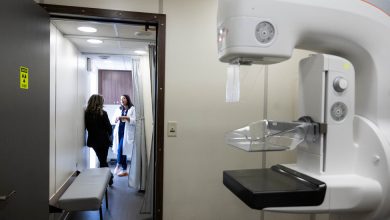Biden’s New Covid Plan: Preparing for New Variants and Avoiding Shutdowns

WASHINGTON — The White House unveiled its long-awaited new coronavirus response strategy on Wednesday, aimed at turning the corner on the worst public health crisis in a century while also preparing for the next threat.
The plan, meant to help the United States transition to what some are calling a “new normal,” has four main goals: protecting against and treating Covid-19; preparing for new variants; avoiding shutdowns; and fighting the virus abroad.
But there is a big hitch: Much of the plan requires funding from Congress. The administration recently told congressional officials it could need as much as $30 billion to sustain the pandemic response. One outside adviser to the White House, Dr. Ezekiel Emanuel, said in an interview that the United States needed to spend much more — on the order of $100 billion over the next year, and billions more after that — to be fully prepared.
“Congress has to think of this as an investment in biosecurity for the country,” said Dr. Emanuel, who led a team of experts in developing a far-reaching coronavirus response plan that it shared with the White House. “We should not be penny-wise and dollar-foolish.”
The strategy comes on the heels of the president’s State of the Union address on Tuesday night and as new U.S. cases decline, though deaths remain high. President Biden used the speech to spotlight a key component: a new “test to treat” initiative that he said would allow Americans to get tested at a pharmacy and, if they are positive, “receive antiviral pills on the spot at no cost.”
Many of the other initiatives in the strategy — including a plan to accelerate research so that vaccines can be developed and deployed within 100 days of variants arising, which was announced in November — are not new. But taken together, they amount to a blueprint for the next phase of the response.
“Make no mistake, President Biden will not accept just ‘living with Covid’ any more than we accept ‘living with’ cancer, Alzheimer’s or AIDS,” the plan declares. “We will continue our work to stop the spread of the virus, blunt its impact on those who get infected, and deploy new treatments to dramatically reduce the occurrence of severe Covid-19 disease and deaths.”
The health secretary, Xavier Becerra, who has been criticized for keeping too low of a profile, made a rare appearance on Wednesday alongside the health officials who hold the weekly White House briefings.
Mr. Becerra highlighted another element of the plan: boosting research into long Covid, the long-term symptoms some people experience after infection. He pledged to open “new centers of excellence” around the country to provide high-quality care to long-Covid patients — which will also require congressional buy-in.
A bipartisan group, led by two former governors, has been pressing Mr. Biden to do more for tens of thousands of children in the United States who have lost parents or caregivers to Covid-19, and the White House apparently listened. The plan says the president will direct federal agencies to review their programs to formulate a more coordinated “bereavement response” for such children, who now number around 200,000.
“This is all part of our commitment to be there for Americans who have long-term physical and mental health needs caused by Covid,” Mr. Becerra said.
The idea behind the strategy is to get the nation out of crisis mode and to a place, Mr. Biden has said, where the virus will no longer disrupt everyday life. It includes a pledge for the administration to work with Congress to “give schools and businesses guidance, tests and supplies to stay open, including tools to improve ventilation and air filtration.”
In interviews, experts generally praised the plan as a good step forward. Dr. Rick Bright, the chief executive of the Rockefeller Foundation’s Pandemic Prevention Institute, called it a “great start,” adding that the plan should “serve as a firm foundation to build upon, to extend our preparedness posture beyond Covid.”
But Jay A. Winsten, the director of the Harvard Initiative on Media Strategies for Public Health, said the 100-day timeline for vaccine development might not be fast enough for a highly transmissible variant like Omicron. The first Omicron sample was collected in South Africa on Nov. 8, he said; the United States reached the peak of the Omicron wave just 67 days later, on Jan. 14.
Mr. Biden came into office more than a year ago with a 200-page plan to combat the pandemic, which was the most pressing challenge in his nascent presidency. But a lot has changed since then.
The Coronavirus Pandemic: Key Things to Know
A new U.S. strategy. The White House unveiled a virus response strategy that aims for a “new normal,” but much of it will need congressional funding. The plan includes a “test to treat” initiative that would provide antiviral medications to patients as soon as they learn they are infected.
Vaccine protection in adolescents. Five months after immunization, two doses of the Pfizer vaccine appeared to offer virtually no defense against moderate illness caused by Omicron among adolescents aged 12 to 17 years, according to new C.D.C. data. Booster shots, however, dramatically increased the protection.
Around the world. As Hong Kong sinks under its worst Covid wave, the brunt is falling on its most vulnerable: migrants, racial minorities and the working class. In New Zealand, violence broke out as the police moved to end a weekslong protest against vaccine mandates.
More than 200 million Americans have been vaccinated. Two new waves — one fueled by the Delta variant, the other by Omicron — have driven up deaths to nearly one million. Covid treatments have been developed, including the Pfizer drug Paxlovid, which will be integral to the “test and treat” initiative.
Although Paxlovid pills have been relatively scarce since they were authorized late last year, Mr. Biden said in his speech on Tuesday that “Pfizer is working overtime to get us one million pills this month and more than double that next month.”
There is an average of about 60,000 new U.S. cases a day, according to a New York Times database. That is far less than the daily average of 800,000 in January, at the peak of the winter surge fueled by Omicron. But it is still much higher than the daily caseload last June, before Delta drove a summer surge.
Even as the White House asserts that things are getting better and new federal guidelines suggest 70 percent of Americans can stop wearing masks for now, large groups of people remain at risk. Children under 5 are not yet eligible for vaccines. On Monday, New York State health officials released data showing that Pfizer-BioNTech’s vaccine is much less effective in preventing infection in 5- to 11-year-olds than in adolescents or adults.
And an estimated seven million Americans have weak immune systems, illnesses or other disabilities that make them more vulnerable to severe Covid. The White House announced last week that it was taking several steps to make masks and tests more accessible to those groups.
But Gregg Gonsalves, an epidemiologist at Yale University, said that with mask mandates dropping around the country, the administration — and in particular the Centers for Disease Control and Prevention, which relaxed its mask guidance last week — had put too much of a burden on vulnerable Americans to protect themselves.
One mask mandate that will not be dropped — at least not for the next few weeks — is the one Mr. Biden imposed on airplanes, trains and other forms of travel. Jeffrey D. Zients, the White House coronavirus response coordinator, said that it would remain in effect until at least March 18, but that the C.DC. is reviewing it.
In his State of the Union address, Mr. Biden called on Congress to provide new funding for the administration to stockpile more tests, masks and pills. And he said that Americans who ordered free at-home tests from a government website, covidtests.gov, would be able to order more next week.
“I cannot promise a new variant won’t come,” Mr. Biden said. “But I can promise you we’ll do everything within our power to be ready if it does.”



